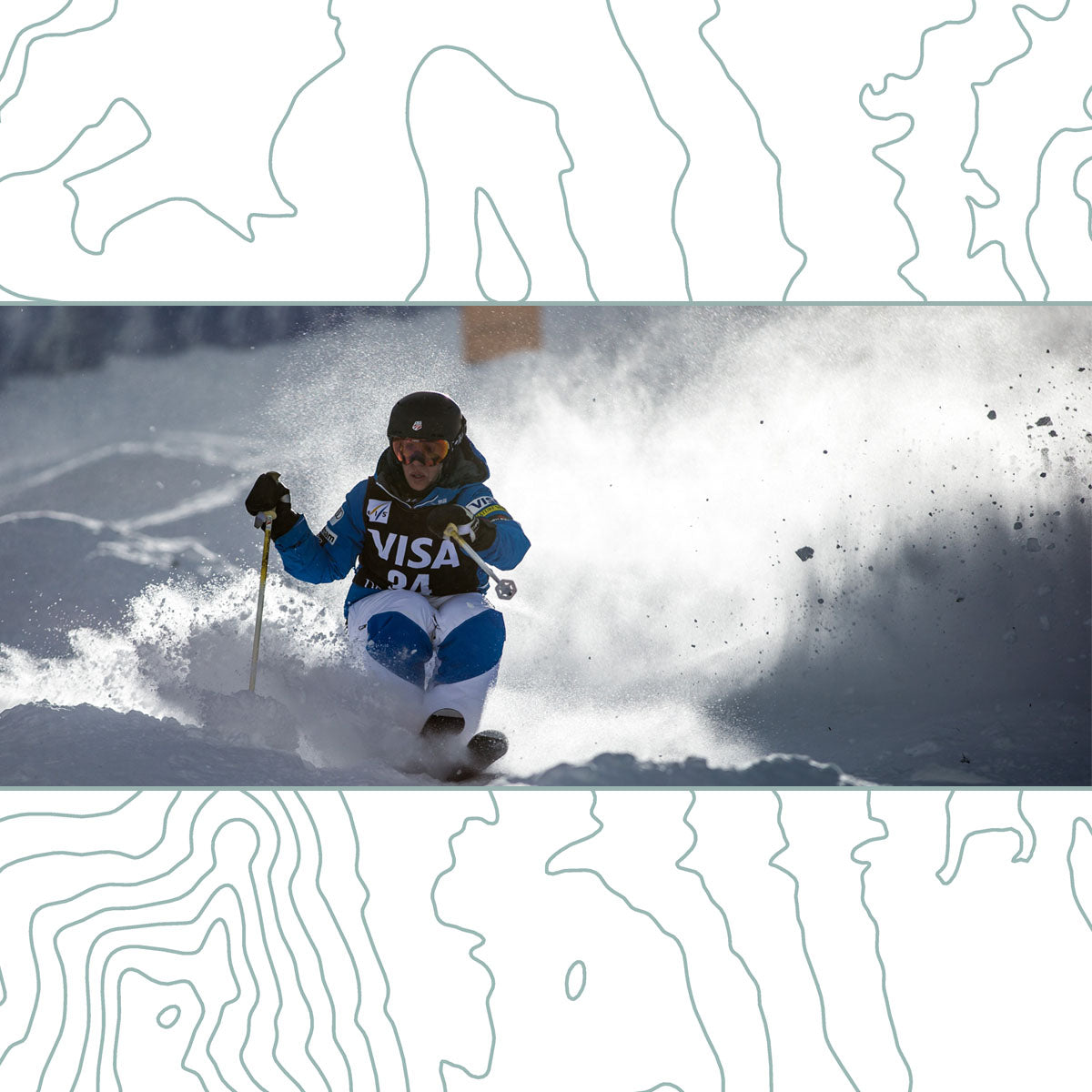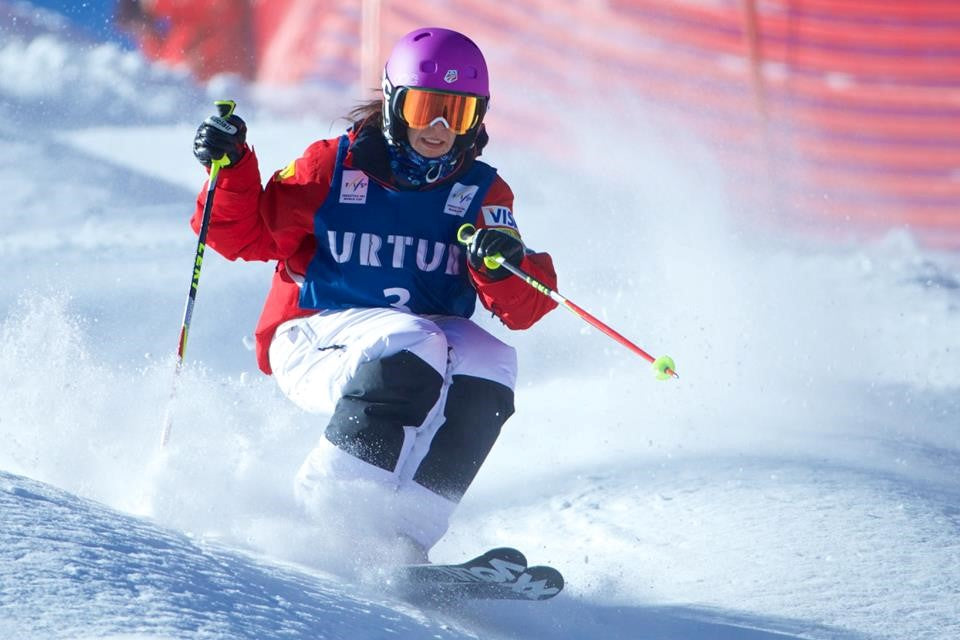5 Tips to Keep Your Knees in Tip-Top Shape for Getting Outside

- by Sophia Schwartz
"Hi, nice to meet you! I'm Sophia, and I was a mogul skier on the US Ski Team!" - me
“You skied moguls?! Yikes- how are your knees?” - Everyone… always!
Yes, this is how the conversation goes when I share my passion for mogul skiing. Truth be told, I have in fact had three knee surgeries. Though, I always point out that my first blown knee came from a field hockey game, not smashing bumps.

With my injury history, my knees need a bit of extra TLC. Thankfully from my professional skiing background plus my experience working in a PT Clinic, I’ve learned a lot about giving them proper care. I’m happy to honestly say that with purposeful upkeep, my knees don’t stop me from living my best life in the mountains. I’m able to carry out my day-to-day skiing and hiking adventures with minimal pain most days, and I’m excited to share some of my tips with you!
1. Keep 'um Moving!
It feels counterintuitive to move if you are hurting, but stiff just gets stiffer! Non-impact and low-impact actives work magic on our joints. For the nerds out there, this is because low impact frequent movement produces an increased amount of synovial fluid in our joints that keeps them lubricated.
If a big hard day is too much right now, set a goal to move three days in a row via walking, biking, Nordic skiing, or swimming for twenty minutes. I bet you’ll not only see benefits for your knees but just moving will lift your spirits as well.

2. Strength Training Makes Dreams Come True
Playing outside is my favorite, and I’d choose a day in the mountains over the gym anytime. However, I have learned to love the gym as well. Weight training can be intimidating, but even some lightweight exercises can greatly improve our knee health. Here are three exercises that are core to my workout routine. They are great entry-level movement patterns, and I added on some additional challenges to keep you progressing.
Rear-foot elevated split squat
Regular squats are great too, but I find that this style of split squat helps you maintain good form no matter your previous strength training experience. Single leg exercises challenge balance, proprioception, and smaller muscle groups while giving you a solid workout.
If you can do twenty body weight squats in a row, level up and add some weights via dumbbells, kettlebells, or barbells!
Bonus points: Add a band around your knee that pulls your knee laterally inwards, also known as a valgus direction. Resisting the band from collapsing your knee inwards will help strengthen your glutes and adductor muscles. Our knees collapse is highly correlated with pain and increased injury risk. It is important to build this strength in the gym, so you have great movement fundamentals outside too!
Clam Shells progression to Side Plank with Leg Lift
As mentioned above, our hips have big strong muscle groups that are super important to keep our knees properly aligned. Clamshells are funky and weird, but they isolate and activate our hip muscles. It is easy to compensate with other muscles in exercise, so it is important to break down movements to target just this muscle group. Clamshells help get up hip strength going, and then we can add in a side plank to integrate the full body.
Bonus points: If you can hold a side plank in good form for one minute, it is time to up the challenge! Add in lifting your top leg during your side planks to put everything to the test. Start with 5 lifts during your minute plank and then try to get up to 10-15 in a minute.
Single leg balance
Our balance is a skill we can work on and SHOULD work on for our whole lives! 75-year-old you will be glad they did! The neural network that helps us know where our body is in space is called proprioception. Practicing balance helps the neural network fire more efficiently. With practice, we not only coordinate the firing of small muscle groups but strengthen them as well. Just like our hips are key to our knees tracking well, our ankles are mobile joints that affect our alignment. It is tempting to shift weight onto the outside of the foot to help avoid the knee collapsing in. However, instead, focus on pressuring your big toe and then imagine twisting your foot outward like a lightbulb into the ground. Your foot should still be facing straight forward, but the rotation aspect activates those hip adductors and glutes that keep knees tracking straight. As you screw your foot into the ground, you should feel the muscle in your hips and behind turn on!
As an additional cue, you can use the same band technique from the split squat. Attach a band that pulls your knee inwards and resist it!
Bonus points: Close your eyes for a tougher challenge! Our vision helps our balance as the sensory input from our eyes chats with the sensory input from our vestibular balance center in our ears- neat!
3. Eccentrics for Down
As a 6-year-old, I first heard one of the adults in our hiking group say, “I feel great on the uphill, but the down gets me.” My child brain was utterly confused as my springy knees were just fine letting gravity pound away down and the up was laborious enough for me to complain. Now, I fully get it! I joke that walking downhill is why I’m a ski mountaineer because sliding on snow is so much better! If you like hiking but hate the down, whelp- backcountry skiing is the best of both worlds!
Walking down is hard because our big quad and glute muscles are working eccentrically or lengthening under load. The muscles are acting as a break and resist gravity as we step down. They contract and shorten while we are stepping up, but they are lengthening and stretching on the down. This produces a greater amount of force. Add in the impact of hitting the ground, and you get a recipe for sore knees! This is also why our quads burn a whole bunch while skiing in the winter!

The good news is we can train eccentric movements and help build the strength needed to handle this demand. Those wonderful exercises above will greatly help too, but here are two exercises that specifically target the down:
Single leg step down
Use the bottom step of your stairs and stand perpendicular to the stairs. Place your uphill foot on the lowest step, and slowly squat so your downhill foot lightly touches the ground. Remember our good knee alignment from above and don’t cheat with your hips to reach for the ground. If you need to grab the railing for extra support, that is a great helper until you gain the strength to control the movement without it.
Heel elevated squats
Going downhill, our ankles are typically pointed down and our shin angles are more forward. Adding something under our heels to elevate them helps mimic this position. You can use a weight plate in the gym. During the squats, slow the lowering movement to take about four to five seconds to reach the bottom. Stand back up at a regular speed. Work to keep your chest upright and proud, rather than bent over facing the ground, by focusing on dropping your hips backward. This body position is super similar to our ski stance. Practice single leg when you are feeling strong to mimic more of a hiking motion! The slow motion will produce the same about of eccentric forces we experience outside and helps prep us for our mountain days!
4. Incremental Addition Year-round
It is September, which means ski season starts in about two and a half months. However, the heart of the winter still gives us plenty of time to prepare. Look ahead on your calendar and work backward. Prepping our bodies won’t happen if we start two days before our holiday ski break or one week before the annual reunion backpacking trip. Knee TLC is a year-round lifelong activity! Learn to make it a habit rather than cramming. This program helps with all sorts of summer and winter activities, but it only works if you do it! Giving time to prep means we can slowly build and add on strength. This program does not feel good if you jump in too hard with too much weight. All good things take time so have patience!
Neuroscience nerds not only study proprioception but also our habits! The best way to add fitness to your daily life is to pair it with a pattern you already have. Practice your single leg balance while you brush your teeth. Pack your gym clothes while you pack your lunch and work laptop. Take your cup of coffee on a walk around the block to get your synovial fluid and caffeine fix on! Pick a manageable routine that you can stick with. Incremental addition over six months keeps your knees feeling a lot better than going super hard for 2 weeks and then burning out!
5. We Get Strong During Rest
Our activities literally rip apart our muscles and stress our tendons and nervous system. Only during our rest, they are able to rebuild stronger! We can’t sustain “go, go, go,” all the time, and rest lets us recover! Rest doesn’t mean sitting on the couch for 7 days in a row, but a restful afternoon walk to enjoy the fall foliage and snuggling up to a movie is delightful. After crushing a big ski weekend or epic hiking trip, check in with your body. Maybe a twenty-minute bike ride to loosen up would be better than a pounding 5k on the pavement. Look ahead, build in real rest days, and bump that run to Wednesday to give your muscle time to level up. Maybe we go hard for 2-3 weeks and then take a full week off to make a full recovery. If something feels off, listen to it. It is perfectly okay to have sore muscles and have your knees swell up a bit after a big effort, but it shouldn’t last more than a few days. Utilize resources like a physical therapist to address the underlying issues that don’t go away in two to three days. The more pain we pile on the longer it takes to fix! Learn to love rest and add in other activities like reading up about the next spot on your adventure list or inviting a friend over to dinner to hear about their most recent powder day!
Knee pain is real and frustrating. Many of us have been sidelined from doing things we love because of it. The good news is that a little goes a long way in feeling better. I hope you put some of these tips into practice and can’t wait to see you out on the trials slopes - and especially in the bumps!

Sophia Schwartz is a former US Ski Team mogul skier and now a professional big mountain skier based in Jackson, WY. She is a big fan of steep slopes, cliffs, jumps, and long walks with friends with heavy packs.













